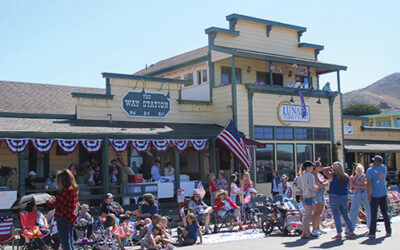Photo is of Morro Bay’s test injection well, which was drilled in the northeast corner of the power plant property, and recently tested effective, meaning the City can now move on to designing and installing more injection wells. Photo courtesy City of Morro Bay
There’s some good news with the City of Morro Bay’s project to recycle its wastewater.
Public Works Director Greg Kwolek said in a news release that the City’s first tests on injecting recycled wastewater into the ground to produce a reliable, drought proof groundwater source, protected against seawater intrusion were successful.
“The results of the Injection test,” Kwolek said, “which involved injection of potable water into the Morro Groundwater Basin via Injection Well No. 1 and monitoring of nearby groundwater conditions, will inform the design of the Indirect Potable Reuse (IPR) Recycled Water injection system.”
The test proved to the City that its scheme to pump tripe-treated and disinfected wastewater into the groundwater basin of Morro Creek will work.
“The test,” Kwolek said, “successfully demonstrated the ability to inject water into the basin to protect against seawater intrusion and improve groundwater quality.”
How does one go about conducting such a test? Kwolek said, “The injection test was initiated on Dec. 6, 2022, with a controlled flow rate of 95-gallons per minute [gpm] being conveyed into the well. The testing was conducted until Jan. 4, 2023.
“During the test, water levels in both the injection well and the nearby monitoring well were recorded on an hourly basis. Water quality data were also tracked to [a] document the quality of the injected water and [b] determine the migration rate of the injected water from the injection well to the nearby monitoring well. Water quality data collected from the monitoring well on Dec. 20, confirmed the arrival of the injection water at that location, which allows the calculation of the migration rate through the aquifer sediments.”
The test results will determine the path forward. “These data,” Kwolek said, “will be useful in both future project planning and for permit acquisition through the Regional Water Quality Control Board. Finally, a series of water quality samples are being collected following cessation of the test to evaluate if geochemical changes occurred within the aquifer following the introduction of the potable water source [State Water Project water].
This means the City can now move on to designing more injection wells and installing the feed water pipes to hook them up to the Water Reclamation Facility treatment plant, officially known as the “Water Resources Center.”
“Next steps for IPR project,” Kwolek said, “will include the design, permitting and construction of the remaining injection wells and advanced purified recycled water pipelines.”
The injection wells would go in the northeast corner of the over 100-acre power plant property, close to Morro Creek.
“The IPR component of the WRF Program,” Kwolek said, “provides the City with a new water supply that will be available regardless of future hydrologic conditions, including climate change, and enables the City to improve the resiliency of its water supply portfolio to mitigate against future droughts and State Water Project infrastructure failures.
It will be the first new water source brought to the City since State Water arrived in the mid-1990s.
State water contracted deliveries have at times been reduced due mainly to drought conditions in Northern California. But the City is protected with an “insurance” allocation, meaning the City pays for double it’s 1,313 acre feet of water under contract, so that the deliveries have to be cut by 50% before the City loses a drop of its annual allocation. The WRF will enhance the City’s water supply.
“Having this local, resilient supply,” Kwolek said, “will provide water security for the City, reduce its reliance on Sacramento-San Joaquin Delta imports, and improve local groundwater quality.”
That recycled water will be pumped out of the ground again via the Morro Basin water wells at Lila Keiser Park. The City uses its former desalination reverse osmosis plant to filter the “fresh water” pumped from the Morro basin wells, then pipes it across town to the Kings Street Water Tanks, where state water also arrives in town.
The filtered Morro basin water is blended with the City’s other water sources — including one well in Chorro Valley near Dana Road — to deliver a consistent quality of water to all of its customers.
But this won’t be a full-time water source, as the plan is to inject the recycled water only a few days a month to keep up the seawater block and supplement the supply.
So long as the State Water Project is being delivered, it will remain the No. 1 source of the City’s drinking water.
There could soon be a wild card thrown into this mix, as the Los Osos Community Services District is now investigating whether it can run a pipeline along South Boulevard and hook up with the Chorro Valley Pipeline (CVP) near Hwy 1.
Morro Bay owns the CVP and the County Flood Control District maintains it. The CVP delivers state water to Morro Bay and Los Osos is seeking to connect to it and get deliveries of state water to the South Bay.



